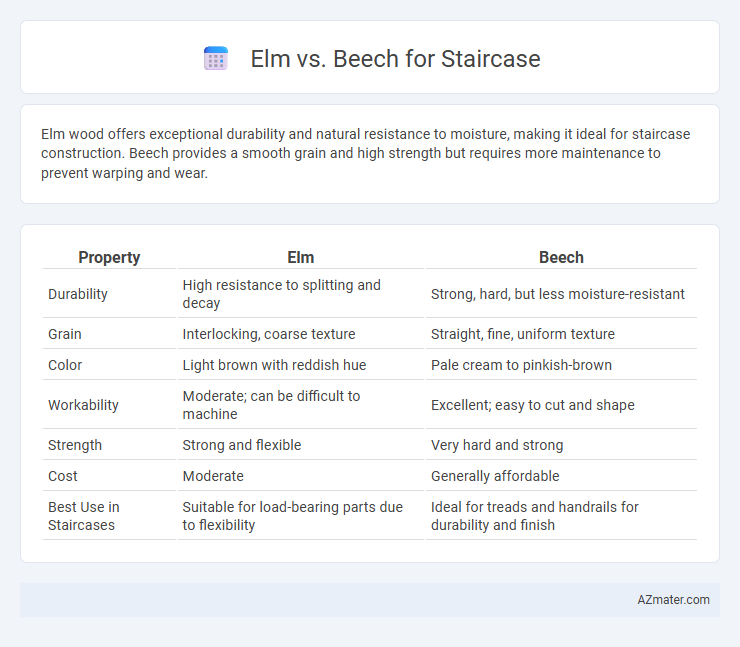Elm wood offers exceptional durability and natural resistance to moisture, making it ideal for staircase construction. Beech provides a smooth grain and high strength but requires more maintenance to prevent warping and wear.
Table of Comparison
| Property | Elm | Beech |
|---|---|---|
| Durability | High resistance to splitting and decay | Strong, hard, but less moisture-resistant |
| Grain | Interlocking, coarse texture | Straight, fine, uniform texture |
| Color | Light brown with reddish hue | Pale cream to pinkish-brown |
| Workability | Moderate; can be difficult to machine | Excellent; easy to cut and shape |
| Strength | Strong and flexible | Very hard and strong |
| Cost | Moderate | Generally affordable |
| Best Use in Staircases | Suitable for load-bearing parts due to flexibility | Ideal for treads and handrails for durability and finish |
Introduction: Elm vs Beech for Staircase Applications
Elm wood offers excellent durability and natural resistance to splitting, making it ideal for staircase applications where strength and longevity are crucial. Beech wood provides a smooth, fine grain and uniform texture that enhances aesthetic appeal and allows for precise machining in staircase components. Both woods are popular choices, but elm's toughness suits structural elements while beech excels in visual finishes.
Wood Characteristics: Elm and Beech Compared
Elm wood is prized for its interlocking grain, which provides exceptional resistance to splitting and enhances durability in staircase construction. Beech wood features a fine, tight grain with a smooth texture that offers a hard, wear-resistant surface ideal for high-traffic staircases. Elm's natural elasticity contrasts with Beech's greater hardness and density, making Elm more flexible and Beech more robust under consistent foot traffic.
Durability and Longevity
Elm offers exceptional durability due to its interlocking grain structure, making it resistant to splitting and ideal for high-traffic staircases. Beech, while also durable with a hard, tight grain, tends to be less resistant to moisture and may show wear faster in humid environments. For longevity, elm staircases often outperform beech, especially in settings prone to heavy use and variable moisture levels.
Appearance and Aesthetic Appeal
Elm wood for staircases features a distinctive grain with interlocking patterns, offering a rustic and warm aesthetic ideal for traditional or country-style interiors. Beech wood presents a smooth, consistent grain and lighter color, providing a sleek and modern appearance suited for contemporary staircase designs. Both woods deliver strong visual appeal, with elm emphasizing natural texture and beech focusing on clean, uniform elegance.
Cost and Availability
Elm wood for staircases offers moderate cost, generally higher than common hardwoods like oak but lower than exotic species, making it a cost-effective choice for its durability. Its availability is limited due to decreased supply from disease impact on elm populations, which can result in higher prices or sourcing challenges in some regions. Beech wood is more affordable and widely available, often found in local lumberyards, providing a cost-efficient option for staircase construction with consistent supply and good workability.
Maintenance and Care Requirements
Elm wood requires moderate maintenance with regular sealing to prevent moisture damage and occasional sanding to remove surface wear. Beech wood demands frequent polishing and protection from humidity to maintain its smooth, light finish and prevent warping or cracking. Both woods benefit from avoiding prolonged water exposure, but beech is generally more sensitive to environmental changes, necessitating more vigilant care.
Workability and Installation Considerations
Elm wood offers excellent workability due to its interlocking grain, making it resistant to splitting and easy to shape for intricate staircase components. Beech wood, known for its uniform texture and fine grain, provides smooth sanding and clean edges, facilitating precise cuts and efficient installation. While elm's natural durability suits curved or detailed banisters, beech's hardness supports stable, wear-resistant treads, impacting the overall staircase assembly time and quality.
Environmental Impact and Sustainability
Elm wood offers moderate sustainability with its slower growth rate and natural resistance to decay, making it a durable yet less commonly harvested option for staircases. Beech wood is highly regarded for its rapid growth and abundance, contributing to better environmental sustainability, though it requires chemical treatments to enhance durability in stair construction. Choosing beech supports more sustainable forestry practices, while elm provides longevity but with a relatively higher environmental footprint.
Best Uses: When to Choose Elm or Beech
Elm is ideal for staircase projects requiring durability and resistance to splitting, making it suitable for high-traffic areas and curved or intricate staircase designs. Beech offers a smooth, fine grain and excellent workability, perfect for elegant, straight staircases where a uniform appearance and ease of finishing are priorities. Choose Elm for robustness and natural resistance, while Beech is preferred for its polished look and ease of shaping in more refined staircase applications.
Conclusion: Selecting the Right Wood for Your Staircase
Elm offers excellent durability and resistance to splitting, making it a strong candidate for staircase construction, especially in high-traffic areas. Beech provides a smooth, even grain with superior shock resistance and a warm, light color, ideal for creating elegant and comfortable staircases. Selecting the right wood depends on prioritizing durability and strength with elm or opting for beech's fine texture and aesthetics to match your interior design.

Infographic: Elm vs Beech for Staircase
 azmater.com
azmater.com